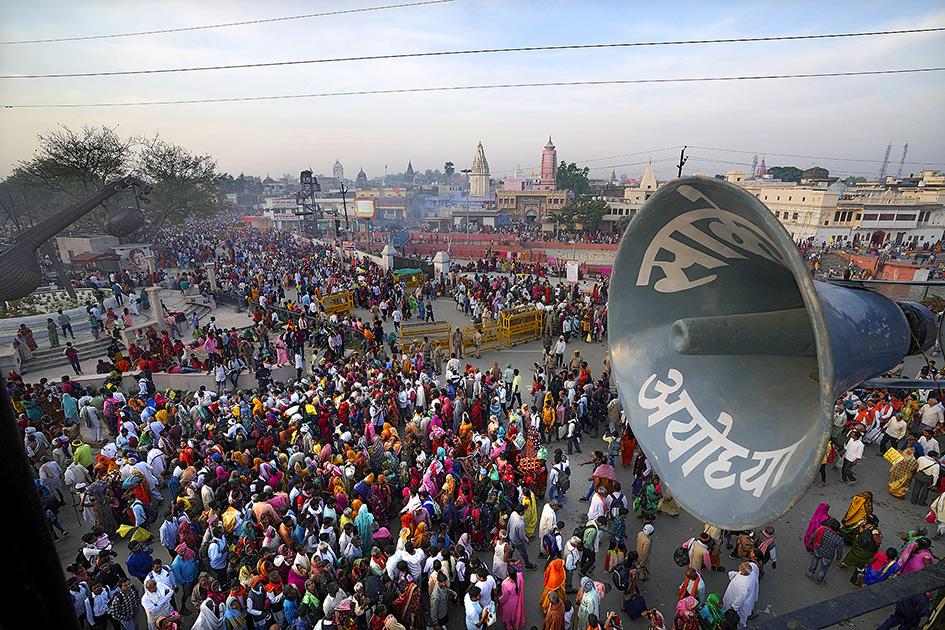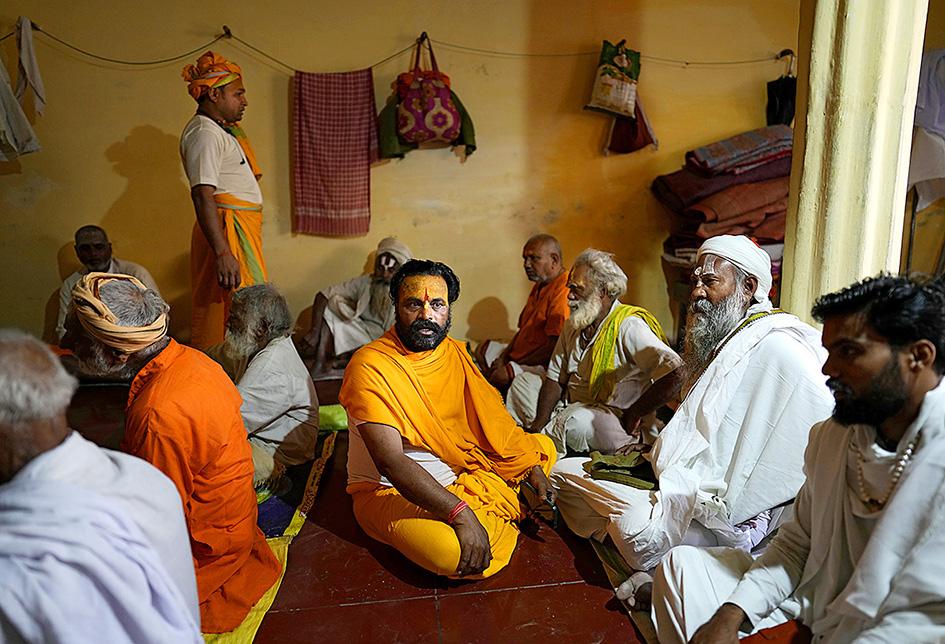Syed Mohammad Munir Abidi says India is a changed country, one he doesn’t recognize anymore.
It’s a country, the 68-year-old says, where Muslims are ignored, where rising attacks against them are encouraged and where an emboldened Hindu majoritarian government is seizing its chance to put the minority community in its place.
Swami Ram Das thinks otherwise, echoing a belief system central to Hindu nationalism.

Photo: AP
The 48-year-old Hindu priest says India is on a quest to redeem its religious past and that the country is fundamentally a Hindu nation where minorities, especially Muslims, must subscribe to Hindu primacy.
Abidi and Das are two ordinary citizens living in one city in a country of more than 1.4 billion people that is on the cusp of becoming the world’s most populated nation. Together they embody the opposing sides of a deeply entrenched religious divide that presents India with one of its biggest challenges: to safeguard freedoms for its Muslim minority at a time when a rising tide of Hindu nationalism is eroding the country’s secular underpinnings.
ANTI-MUSLIM FURY

Photo: AP
India is home to some 200 million Muslims who make up the predominantly Hindu country’s largest minority group. They are scattered across almost every part of India, where a systemic anti-Muslim fury has descended since Prime Minister Narendra Modi first assumed power in 2014.
Though India’s communal fractures date back to its bloody partition in 1947, most Indians trace the roots of the latest religious fault lines to a small temple city in northern India, where the Hindu nationalist movement was galvanized in 1992 after Hindu mobs demolished a historic mosque to make way for a temple.
Since then, the city of Ayodhya has, in many ways, become a religious microcosm of India, where a diverse, multicultural past has gradually been overrun by ruptured relationships between Hindus and Muslims.
It’s also a city Abidi and Das call home.
They have meandered through its narrow, winding streets overrun by temple monkeys and Hindu monks who ask passersby for blessings in exchange for alms. They have walked past its brimming bazaars where miniature idols of Ram are sold to pilgrims visiting from India’s vast hinterlands. They have begun their mornings with calls for prayers spilling out of mosque loudspeakers and Vedic hymns chant in the temples.
Beyond these shared experiences lie stark differences.
For Das, a broad-shouldered man with a stout frame, Ayodhya is the birthplace of Ram, Hinduism’s most revered deity. The city also hosts one of Hinduism’s most sacred sites — Ram’s grand temple — which will open to pilgrims next year. It is imperative that the city clings to its Hindu character, Das says.
“Our forefathers have fought for this temple and sacrificed lives for it. Today their dream is getting fulfilled,” he says, circled by a group of devotees.
The temple is being constructed where the 16th-century Babri mosque was demolished by Hindu hardliners who claim Muslim rulers built it at the exact spot where Ram was born. When it was razed on Dec. 6, 1992, Das was there, watching a frenzied Hindu mob climb its rounded domes and tear it down with pickaxes and crowbars.
“There was so much excitement to destroy that disgraced structure that no one cared about the falling debris,” he recounts, prompting his disciples to chant “Jai Sri Ram,” or “Hail Lord Ram,” a slogan that has become a battle cry for Hindu nationalists.
The 30-year campaign to build the temple saw subsequent religious violence and a bitter legal battle over the site that Hindus won in 2019. Muslims were given alternate land on the city outskirts to build a new mosque. A year later, Modi attended the temple’s groundbreaking ceremony.
For Abidi, a tall man in clothes that hang off his frame, it marked a sad chapter for India’s Muslims.
“The hearts of Muslims are broken. No Muslim opposes the construction of Ram temple, but such unilateral changes are impacting India’s culture,” he says, arguing the former mosque was essential to the city’s Muslim identity.
ERASING
As for his city, it has already gone through major changes.
For decades Ayodhya city was part of Uttar Pradesh state’s Faizabad district. But in 2018, authorities changed the entire district’s name from Faizabad to Ayodhya, a move that reflected the Modi government’s pattern of replacing prominent Muslim geographic names with Hindu ones.
For Abidi it indicates a worrying trend: “To erase everything that remotely reflects Muslim culture.”
Today, Ayodhya is taken over by frenetic construction of hotels, bringing in tens of thousands of Hindu pilgrims. Construction workers are busy making way for wider highways. All that is expected to boost the city’s economy. But at what cost, Abidi reckons.
“The relationship Hindus and Muslims used to share is barely visible anymore,” he says.
India’s religious fault lines have become pronounced under Modi. Scores of Muslims have been lynched by Hindu mobs over allegations of eating beef or smuggling cow, an animal considered holy to Hindus. Muslim businesses have been boycotted, their localities have been bulldozed and places of worship set on fire. Sometimes open calls have been made for their genocide.
MODI’S SILENCE
Critics say Modi’s conspicuous silence over such attacks has emboldened some of his most extreme supporters and enabled more hate speech against Muslims.
Muslims have been falsely accused of manipulating Hindu women into marriages and producing more children to establish domination. The government data shows otherwise: India’s religious composition has been largely stable since 1947 and the fertility rate of Muslims has declined from 4.4 in 1992 to 2.3 in 2020.
“It is never going to be possible if you look at the data. We should forget and ignore this rhetoric,” says Poonam Muttreja, director at the Population Foundation of India.
Muslims also have the lowest literacy among all major Indian religious communities. They have faced discrimination in employment and housing and hold a little less than 5 percent of seats in the parliament, their lowest share ever.
For Abidi, all this represents a grim future, one where India’s secular character lives only in people’s memories.
“Every Muslim in today’s India finds himself unsafe,” he says.
Das disagrees, arguing that Muslims are still free to pray and practice their religion. “But we will correct the mistakes made by your ancestors.”
Das is referring to the Mughals who ruled India before the British made it their colony.
Scorn for Mughal rulers, who are not ancestors of Indian Muslims and only shared a similar faith, is distinctive to India’s Hindu nationalists, who claim Mughals destroyed Hindu culture. It has prompted Hindu nationalists to seek ownership of hundreds of historic mosques they say are built over demolished temples.
In Ayodhya, longtime Muslim locals have made compromises to avoid tension with Hindu neighbors.
Last year when the Muharram procession overlapped with a Hindu festival, Muslim leaders changed the timing of their march to avoid confrontation. This year, Muslims in the city had to forgo selling and consumption of meat during another Hindu festival that coincided with the beginning days of Ramadan.
In such an atmosphere, Abidi says, only religious tolerance can stop India’s communal fractures from worsening.
“India will only survive if we mend hearts and not break them,” he says.